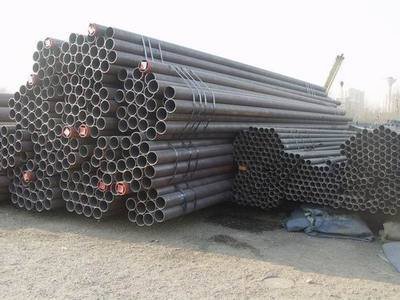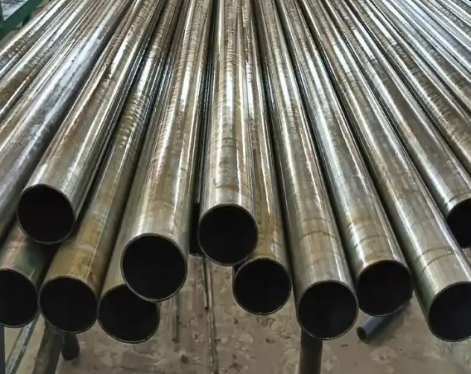Decarburization of seamless pipe refers to the phenomenon that the carbon content of steel pipe is reduced. Decarburization is easy to occur when the heating temperature of steel pipe is too high or the residence time at high temperature is too long. Sometimes accompanied by severe surface oxidation. Factors affecting steel decarburization include chemical composition of steel material, heating temperature, holding time and gas composition.
1. Effect of chemical composition of steel material on decarburization
The chemical composition of the tube blank has a great influence on decarburization. The higher the carbon content in the tube blank, the greater the decarburization tendency. Elements such as W, Al, Si, and Co all increase the decarburization tendency of steel; while elements such as Cr and Mn can prevent decarburization of steel.
2. Influence of heating temperature
As the heating temperature increases, the depth of the decarburized layer increases continuously. Generally, when the temperature is lower than 1000 °C, the scale on the surface of the steel pipe hinders the diffusion of carbon, and decarburization is slower than oxidation. However, as the temperature rises, on the one hand, the formation rate of oxide scale increases, and on the other hand, the diffusion rate of carbon under the oxide scale also accelerates. At this time, the oxide skin loses its protective ability, and after reaching a certain temperature, decarburization is faster than oxidation.

3. Influence of holding time and heating times
The longer the heating time, the more heating times, the deeper the decarburization layer, but the decarburization layer does not increase proportionally to the time.
4. Effect of furnace gas on decarburization
(1) During the heating process, due to the different fuel components, combustion conditions and temperatures, the combustion products contain different gases, thus forming different gases in the furnace, which are oxidizing and reducing. Their effects on steel pipes are different. The oxidizing gas causes the oxidation and decarburization of steel, among which the medium with the strongest decarburization ability is H2O, followed by CO2 and O2, and finally H2. Some gases, such as CO and CH4, carburize steel.
(2) The air excess coefficient α in the furnace also has an important impact on decarburization: when α is too small, H2 appears in the combustion products, and the decarburization rate in moist hydrogen increases with the increase of water content. Therefore, heating in a gas non-oxidizing heating furnace will also cause decarburization when the furnace gas contains more H2O. When the gas α is too large, due to the formation of more scales, it hinders the diffusion of carbon, so the depth of the decarburization layer can be reduced. Decarburization is minimized when heated in a neutral medium.
In conclusion
For steel pipes that need to be quenched, decarburization reduces the carbon content of the surface layer. After quenching, martensitic transformation cannot occur, or the transformation is incomplete. As a result, the required hardness cannot be obtained. In severe cases, the steel pipe will be scrapped.
1. Effect of chemical composition of steel material on decarburization
The chemical composition of the tube blank has a great influence on decarburization. The higher the carbon content in the tube blank, the greater the decarburization tendency. Elements such as W, Al, Si, and Co all increase the decarburization tendency of steel; while elements such as Cr and Mn can prevent decarburization of steel.
2. Influence of heating temperature
As the heating temperature increases, the depth of the decarburized layer increases continuously. Generally, when the temperature is lower than 1000 °C, the scale on the surface of the steel pipe hinders the diffusion of carbon, and decarburization is slower than oxidation. However, as the temperature rises, on the one hand, the formation rate of oxide scale increases, and on the other hand, the diffusion rate of carbon under the oxide scale also accelerates. At this time, the oxide skin loses its protective ability, and after reaching a certain temperature, decarburization is faster than oxidation.

3. Influence of holding time and heating times
The longer the heating time, the more heating times, the deeper the decarburization layer, but the decarburization layer does not increase proportionally to the time.
4. Effect of furnace gas on decarburization
(1) During the heating process, due to the different fuel components, combustion conditions and temperatures, the combustion products contain different gases, thus forming different gases in the furnace, which are oxidizing and reducing. Their effects on steel pipes are different. The oxidizing gas causes the oxidation and decarburization of steel, among which the medium with the strongest decarburization ability is H2O, followed by CO2 and O2, and finally H2. Some gases, such as CO and CH4, carburize steel.
(2) The air excess coefficient α in the furnace also has an important impact on decarburization: when α is too small, H2 appears in the combustion products, and the decarburization rate in moist hydrogen increases with the increase of water content. Therefore, heating in a gas non-oxidizing heating furnace will also cause decarburization when the furnace gas contains more H2O. When the gas α is too large, due to the formation of more scales, it hinders the diffusion of carbon, so the depth of the decarburization layer can be reduced. Decarburization is minimized when heated in a neutral medium.
In conclusion
For steel pipes that need to be quenched, decarburization reduces the carbon content of the surface layer. After quenching, martensitic transformation cannot occur, or the transformation is incomplete. As a result, the required hardness cannot be obtained. In severe cases, the steel pipe will be scrapped.









